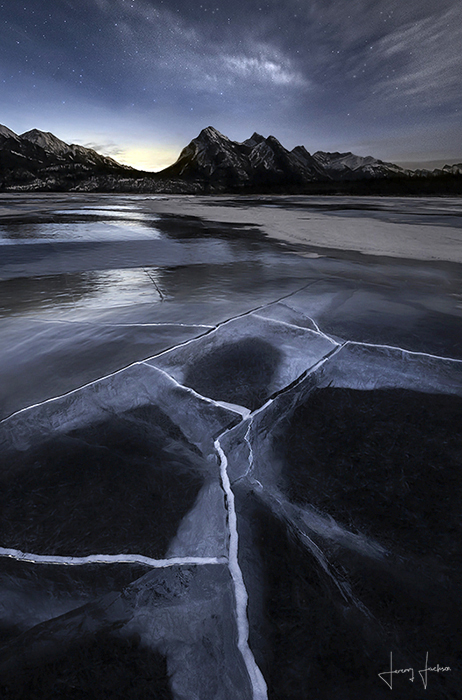


Welcome to the Maru Landscapes Blog. Here, I will share with you my latest images, techniques, and thoughts on landscape photography. From the best places to go, to the best equipment and techniques to use, you will find it here. I hope you enjoy the blog and come to visit often.
Jeremy Jackson

There is always some luck in landscape photography and this image was no exception. I had no idea that the sun would rise over the mountains in the distance and so did not plan for the beautiful yellow and orange glow on the low horizon or the under lighting on the clouds.
I set up my 14-24mm lens about 2 feet from the ice and roughly 6 feet from the diamond shaped crack in the mid ground. Since I had broken my cable release earlier in the trip, the longest exposure I could use was 30 seconds. In the 7 am dark, lit only by a half moon, 30 seconds was not long enough to expose the ice at ISO 400 and f8 (my preferred settings for this kind of shot). This forced me to shoot the foreground at f4 instead of f8 and so required focus stacking to achieve sharpness throughout the image. After making 4 focus stacked exposures for the ice at 30 seconds, ISO 400 and f4, I turned my attention to the sky and mountains in the distance. This required only one exposure for 13 seconds at f4 and ISO 1000. The entire process took about 10 minutes and resulted in a cohesive, true to life final image.The location and timing of the sunrise was also very important to the final appearance of the image. The photograph of the sky was made about 1 hour before sunrise at around 7:45 am. To the naked eye, the orange glow in the saddle of the mountains was barely visible. But when using ISO 1000, light areas of an image register relatively more brightly on the image sensor than surrounding dark areas. This caused the wonderful glow of pre-dawn light on the horizon.
Finally, the low sun rising underneath the clouds in the center of the sky had the effect of lighting the cloud and making it stand out in the sky.
Although the conditions were critical, there is some Photoshop work here. But really, the only major adjustment I made was to the hue and saturation of the sky. I lowered the saturation of the sky and made it less cyan thereby creating a more cohesive sky, foreground relationship. Other than stitching together the focus stacked images, that's it! I hope you enjoy the image and feel free to email me about it if you would like to know more.
